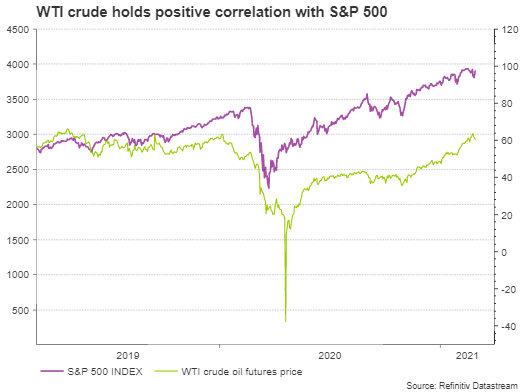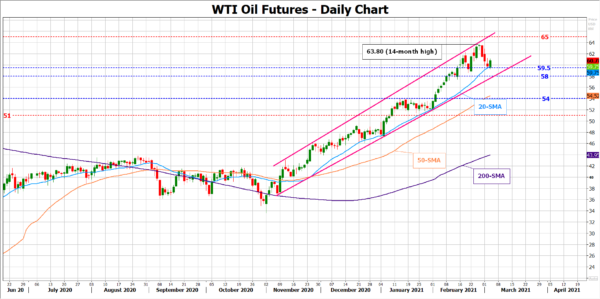With oil prices soaring more than 70% during the past three months, the OPEC oil cartel is facing increasing calls to start boosting its output amid rising optimism the vaccine rollouts and the loosening virus-related curbs could bolster demand for the commodity. On Thursday, the group could respond by further easing its output caps, though whether such a decision could be enough to knock oil prices down may depend on how generous the supply increase would be.
OPEC to ease production cuts in April
After days of intense discussions, OPEC and its partners, known as OPEC+ decided in December to increase production by 500,000 barrels per day (bpd) beginning in January and extending through the first quarter of the new year. The announcement followed a record decline in production in the second half of 2020 aimed to balance the exceptional market challenges caused by the global lockdown, with producers slashing output by 9.7mln bpd in May before easing restrictions to just over 7mln bpd in January, or 7% of global supply.
During Thursday’s videoconference, the OPEC community is expected to return an extra 500,000 bpd in April, and there is a growing speculation that Saudi Arabia could also scrap its voluntary 1mln bpd cutback, which expires at the end of March. The final decision however may converge to a smaller supply increase than analysts are pricing in as the uncertainty surrounding the new virus strains and their resilience to the vaccines suggests that lockdown measures and the struggling aviation industry may keep restricting oil consumption for longer, or at least until the immunization requirements are finally met.
Supply talks could test Russia – Saudi Arabia relations
Perhaps pressure from Russia, which has a lower budget breakeven oil price than the Saudis, and therefore can absorb negative financial shocks better, may push the group to release an extra 500,000 bpd. However, whether Saudi Arabia could fully reverse its voluntary cuts, or cautiously remove only a portion of it to allow its producers to enjoy higher prices a bit more, remains to be seen.
Note that NYMEX WTI oil future contracts have been softly trending downwards since mid-February, while China, which is the largest oil consumer after the US, is experiencing a slowing expansion rate in manufacturing activities, with the Caixin manufacturing PMI dropping for the third consecutive month to a nine-month low in February. Hence, any boost in production beyond 500,000 bpd may be carefully studied.
On the other hand, raising too little could trigger another spike in oil prices, which could consequently add more fuel to inflationary fears, and make an economic recovery in growth-leading economies such as India more costly.
From a technical perspective, WTI crude oil futures have not entered a bearish area yet despite the latest pullback from a one-year peak of 63.80, and the strong positive correlation with the S&P 500 has yet to send any negative warnings. If the output hike falls short of expectations on Thursday, WTI oil price could revisit its 63.80 top. Slightly higher, the surface of the bullish channel could also pause the rally within the 64.70 – 65.00 region.
Alternatively, if the OPEC members appear more optimistic about the global economic expansion, raising oil output more than forecasts suggest, it would be interesting to see if the price can violate the strong support around the 20-day simple moving average (SMA) and dip towards the 58.00 barrier. Lower, a break below the channel could trigger a more aggressive sell-off, turning the spotlight towards the 54.00 level.
Overall, however, with the virus jitters remaining well intact on the immediate horizon, a production increase at this stage may not be enough to fill the demand-supply gap in the oil market, likely keeping prices elevated at least in the near term.














